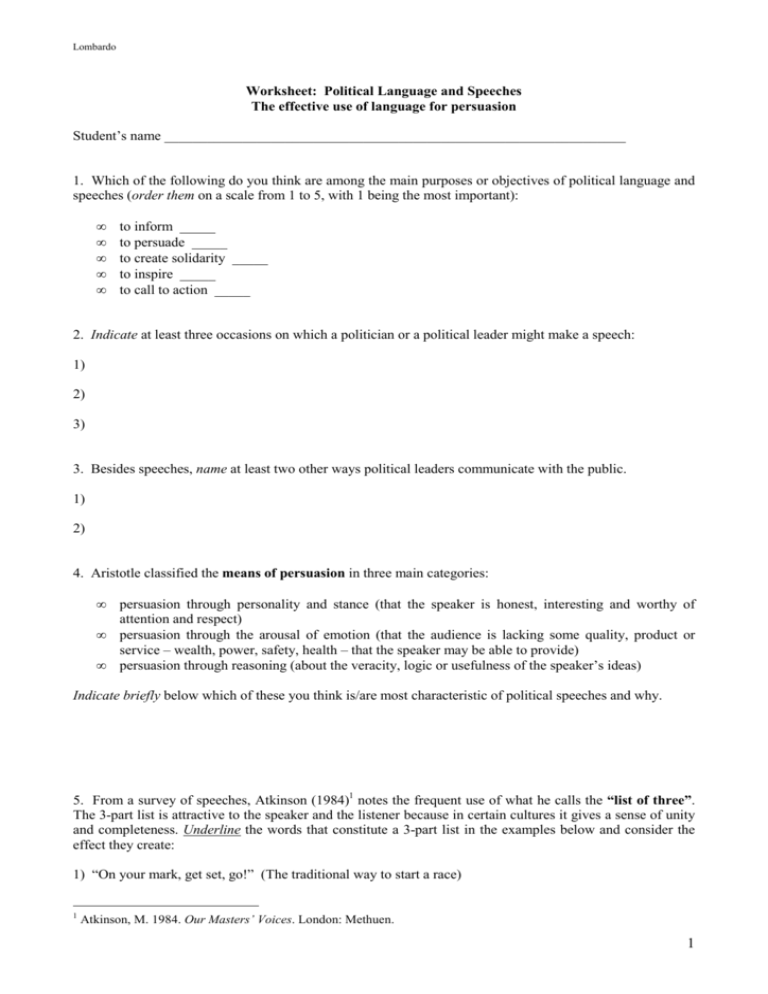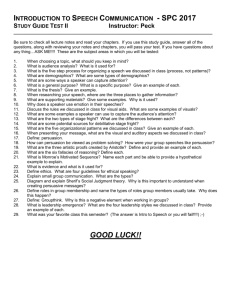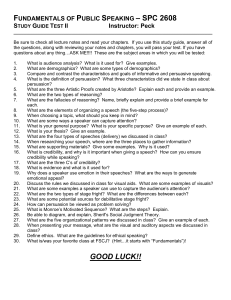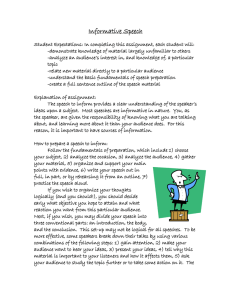Lombardo scienze politiche III anno 1 Political language and
advertisement

Lombardo Worksheet: Political Language and Speeches The effective use of language for persuasion Student’s name _________________________________________________________________ 1. Which of the following do you think are among the main purposes or objectives of political language and speeches (order them on a scale from 1 to 5, with 1 being the most important): • • • • • to inform _____ to persuade _____ to create solidarity _____ to inspire _____ to call to action _____ 2. Indicate at least three occasions on which a politician or a political leader might make a speech: 1) 2) 3) 3. Besides speeches, name at least two other ways political leaders communicate with the public. 1) 2) 4. Aristotle classified the means of persuasion in three main categories: • • • persuasion through personality and stance (that the speaker is honest, interesting and worthy of attention and respect) persuasion through the arousal of emotion (that the audience is lacking some quality, product or service – wealth, power, safety, health – that the speaker may be able to provide) persuasion through reasoning (about the veracity, logic or usefulness of the speaker’s ideas) Indicate briefly below which of these you think is/are most characteristic of political speeches and why. 5. From a survey of speeches, Atkinson (1984)1 notes the frequent use of what he calls the “list of three”. The 3-part list is attractive to the speaker and the listener because in certain cultures it gives a sense of unity and completeness. Underline the words that constitute a 3-part list in the examples below and consider the effect they create: 1) “On your mark, get set, go!” (The traditional way to start a race) 1 Atkinson, M. 1984. Our Masters’ Voices. London: Methuen. 1 Lombardo 2) “That this nation, under God, shall have a new birth of freedom – and that government of the people, by the people, for the people shall not perish from the earth.” (Abraham Lincoln, the ‘Gettysburg Address’, on the site of one of the decisive battles of the American Civil War, 1863) 3) “Never in the field of human conflict has so much been owed by so many to so few.” (Winston Churchill, praising the fighter pilots in the Battle of Britain, 1940) 4) “Friends, comrades and fellow South Africans, I greet you all in the name of peace, democracy and freedom for all.” (Nelson Mandela in his first speech on his release from prison in 1990) 5) “North Korea is a regime arming with missiles, Iran pursues its weapons, while Iraq continues to support terrorism.” (George W. Bush, ‘Axis of Evil’ speech, 2002) 6. Another rhetorical device has its origin in Classical Greek and Roman antithesis. Atkinson calls it the contrastive pair since it contains two parts in some ways in opposition, and uses repetition to create the overall effect, as in the following examples from famous speeches: 1) “One small step for man: one giant leap for mankind.” _____ 2) “Where there is discord, may we bring harmony. Where there is error, may we bring truth. Where there is doubt, may we bring faith. Where there is despair, may we bring hope.” _____ 3) “I stand before you not as a prophet but as a humble servant of you, the people […] we have waited too long for our freedom. We can no longer wait.” _____ 4) “Tough on crime and tough on the causes of crime.” _____ 5) “Friends, Romans and countrymen, lend me your ears. I come to bury Caesar, not to praise him.” _____ Match each text above with the speaker and context below by putting the appropriate letter in the blank which follows the text: a) Nelson Mandela in his first speech on his release from prison in 1990. b) In Shakespeare’s Julius Caesar, the opening lines of Mark Antony’s speech to the crowd, who have been persuaded by Brutus that Caesar deserved to die. c) Prime Minister Margaret Thatcher, paraphrasing the words of St. Francis of Assisi, as part of her victory speech in 1979. d) US astronaut Neil Armstrong when he became the first person to set foot on the moon in 1969. e) Tony Blair, for the Labour Party, in the run-up to the 1997 election in Britain. Notice how example 4 functions as a soundbite: a kind of slogan which is easy to repeat and to remember and, it is hoped, will be cited by the media. Now volunteer to read one of these short texts out loud in class in a communicative way. 7. Other effective communication strategies are: • the use of repetition - of the same word or structure, of different forms of a word, of related words. • the use of language which is very strong in meaning, e.g. only once, fundamentally, entire. • the use of personal pronouns. The first person singular forms - I/me/mine - communicate the personal involvement and the responsibility or authority of the speaker; the first person plural forms – we/us/our create a sense of solidarity, shared values and responsibility. Underline examples of repetition, strong language and personal pronouns in the text below, and reflect on the effect they have on the reader/listener: “Only once in a generation is the tax system fundamentally reformed. The budget I bring before the House and country today begins the task of modernising not just taxation but the entire tax and benefit systems of our country. We do this to encourage enterprise; to reward work; to support families; to advance the ambitions not just of the few but of the many.” (Gordon Brown, British Chancellor of the Exchequer, in the opening of his 1998 budget speech) Write brief answers to the questions below: 2 Lombardo 1) Who do we and our refer to? What is the difference between using I and using we? 2) Which part of the speech would make a good soundbite and why? 8. Metaphor is the fundamental way in which we construct the world around us and it is a powerful communicative device, also because it expresses an evaluation. Metaphor is based on analogy or the comparison of two apparently very different entities, which have some things in common. Consider, for example, the Italian ad for Ballantine’s whiskey: “Ballantine. Seta scozzese”. What could whiskey and silk have in common and what does “seta scozzese” suggest? What kind of evaluation of the product is implied? How does the use of metaphor stimulate the reader or listener to make sense of the metaphor? How many associations can be made? Will they be the same or different from person to person? Now read the text below, which is the opening of US President Bill Clinton’s inaugural address in January of 1993. What is the overriding metaphor? Underline all the words or phrases related to that metaphor. What other metaphors can you find? Underline them. Now find repetitions, a list of three, and three contrastive pairs. Put a circle around them. “My fellow citizens: Today we celebrate the mystery of American renewal. This ceremony is held in the depth of winter. But, by the words we speak and the faces we show the world, we force the spring. A spring reborn in the world’s oldest democracy, that brings forth the vision and courage to reinvent America. When our founders boldly declared America’s independence to the world and our purposes to the Almighty, they knew that America, to endure, would have to change - not change for change’s sake, but change to preserve America’s ideals: life, liberty and the pursuit of happiness. Though we march to the music of our time, our mission is timeless. Each generation of Americans must define what it means to be an American. On behalf of our nation, I salute my predecessor, President Bush, for his half-century of service to America. And I thank the millions of men and women whose steadfastness and sacrifice triumphed over depression, fascism and communism. Today, a generation raised in the shadows of the Cold War assumes new responsibilities in a world warmed by the sunshine of freedom but threatened still by ancient hatreds and new plagues.” Write brief answers to the following questions. 1) Notice the words America and American; how many times is some form of these two words used? 2) How is the nation personified, that is, given the attributes of a person? 3) How are Americans characterized? 4) What quasi-religious words are associated with America and American(s)? Source: Adapted from Beard, A., 2000, The Language of Politics. Routledge: London and from Partington, A., 2006, Persuasion in Politic. LED, Milan. 3 Lombardo 9. John F. Kennedy, the 35th President of the United States, was considered a fine public speaker by colleagues and opponents alike and phrases from some of his most famous speeches are still quoted today. On the next page are passages from three important speeches: a) a speech announcing the institution of the Peace Corps, b) a speech on the role of the United Nations, and c) his inaugural address in 1960. 1) Make brief notes here about what you know about the situation in the US, in the West and internationally in the early 1960s at the height of the Cold War and what you know or can imagine from his presidential campaign slogan, ‘the New Frontier’ 2) Read quickly through the passages from the three speeches on pages 6 and 7 to get a general idea of what they say. Match each text with the speech you think it was taken from (a, b, or c). Notice the differences in tone and register. Indicate what you think is the main objective of each speech. Text 1:__________________________________________________________________________ Main objective:_________________________________________________________________ Text 2:__________________________________________________________________________ Main objective:_________________________________________________________________ Text 3:__________________________________________________________________________ Main objective:_________________________________________________________________ 3) Let’s look at the some of the important concepts expressed in Text 1 in a highly rhetorical way. Indicate briefly in ordinary language what you think is meant by each the following phrases (the first two have been done for you): a) the power to abolish all forms of human poverty and all forms of human life (lines 4-5): reformulation: scientific and technological advances have made it possible to feed the world and cure disease but have also make possible nuclear bombs and total destruction. b) the same revolutionary beliefs for which our forebears fought (lines 5-6): reformulation: The founders of the United States of America fought the American Revolution, sometimes called the War of Independence, for freedom, independence and democracy. c) we are the heirs of that first revolution (line 8): d) the torch has been passed (line 9): 4 Lombardo e) tempered by war (line 10): f) disciplined by a hard and bitter peace (line 10): g) struggling to break the bonds of mass misery (lines 19-20): h) the dark powers of destruction, unleashed by science (line 22): i) the glow from that fire can truly light the world (line 30): 4) Indicate to whom you think Kennedy is referring in each of the following phrases in Text 1: a) Let every nation know (line 13): b) To those people in the huts and villages of half the globe (line 19): c) To those nations who would make themselves our adversary (line 20-21): d) So let us begin anew, remembering on both sides (line 24): 5) Notice the use of I , you, your (lines 2, 27, 28, 31-32). What function does I have? And you and your? Now notice the use of we, us, and our (lines 1, 3, 5, 8, 10, 12, 13, 15, 16, 19, 20, 21, 24, 25, 28, 29). What do they communicate? 6) Now listen to JFK delivering these speeches. Indicate briefly below how the delivery is different in each of the three speeches, with reference to: a) tone of voice: b) volume: c) speed: d) pauses for emphasis: e) rhythm: f) blocking (division into separate units) of the text: 5 Lombardo 7) With respect to Kennedy’s overall use of language, particularly the rhetorical devices used in persuasion, find at least one example (indicate the text number and the lines where it is found) that shows: a) the use of personality and moral values: b) the arousal of emotion: c) the logic of reasoning: d) the use of the 3-part list: e) the use of the contrastive pair: f) the use of strong language: g) the use of repetition and parallel structures: h) the use of metaphor: i) the use of alliteration: 8) Indicate briefly how effective you think these speeches would be today and what you think has changed: What about the use of non-sexist language? Notice the generic use of “man”, “he” (Text 1, lines 4 and 6), “manpower”(Text 2, line 4), “men” (Text 3, line 11) for both men and women. Indicate below how you think these concepts would be expressed today in language that does not make women ‘invisible’: “man”, “he” > ______________________________________ “manpower”> _______________________________________ “men” > ___________________________________________ J. F. Kennedy Text 1 “We observe today not a victory of party, but a celebration of freedom, symbolizing an end as well as a beginning, signifying renewal as well as change; for I have sworn before you and almighty God the same solemn oath our forebears prescribed nearly a century and three quarters ago. The world is very different now, for man holds in his mortal hands the power to abolish all forms of human poverty and all forms of human life, and yet the same revolutionary beliefs for which our forbears fought are still an issue around the globe: the belief that the rights of man come not from the generosity of the State but from the hand of God. We dare not forget today that we are the heirs of that first revolution, let the word go forth from this time and place to friend and foe alike, that the torch has been passed to a new generation of Americans, born in this century, tempered by war, disciplined by a hard and bitter peace, proud of our ancient heritage and 6 Lombardo unwilling to witness or permit the slow undoing of those human rights, to which this nation has always been committed and to which we are committed today at home and around the world. Let every nation know – whether it wishes us well or ill, that we shall pay any price, bear any burden, meet any hardship, support any friend, oppose any foe to assure the survival and the success of liberty. United there is little we cannot do, in a host of cooperative ventures. Divided there’s little we can do, and to remember that, in the past those who foolishly sought power, by riding the back of the tiger, ended up inside. To those people in the huts and villages of half the globe, struggling to break the bonds of massmisery we pledge our best efforts to help them help themselves. To those nations who would make themselves our adversary, we offer not a pledge but a request: that both sides begin anew the quest for peace, before the dark powers of destruction, unleashed by science, engulf all humanity in planned or accidental self-destruction. So let us begin anew, remembering on both sides that stability is not a sign of weakness, and sincerity is always subject to proof. Let us never negotiate out of fear, but let us never fear to negotiate. In the long history of the world only a few generations have ever been granted the role of defending freedom in its hour of maximum danger. I do not shrink from this responsibility, I welcome it. I do not believe that any of us would exchange places with any other people or any other generation. The energy, the faith, the devotion that we bring to this endeavour will light our country and all who serve it and the glow from that fire can truly light the world. And so my fellow Americans, ask not what your country can do for you, ask what you can do for your country.” Text 2. “I have today signed an executive order providing for the establishment of a peace corps on a temporary pilot basis. This corps will be a pool of trained men and women sent overseas by the United States Government or through private institutions and organizations to help foreign countries meet their urgent needs for skilled manpower. We will send Americans abroad who are qualified to do a job. We are going to put particular emphasis on those men and women who have skills in teaching, agriculture and in health. I am hopeful that it will be a source of satisfaction to Americans and a contribution to world peace.” Text 3. “Yet our basic goal remains the same: a peaceful world community of free and independent states, free to choose their own future and their own system, so long as it does not threaten the freedom of others. Some may choose forms and ways that we would not choose for ourselves, but it is not for us that they are choosing. We can welcome diversity that communists cannot, for we offer a world of choice and they offer a world of coercion, and the way of the past shows clearly that freedom – not coercion – is the way of the future. At times our goal has been obscured by crisis, or endangered by conflicts, but it draws sustenance from five basic sources of strength: the moral and physical strength of the United States; the united strength of the Atlantic community; the regional strength of our hemispheric relations; the creative strength of our efforts in the new and developing nations; and the peacekeeping strength of the United Nations. Arms alone are not enough to keep the peace: men must keep it. Our instrument and our hope is the United Nations, and I see little merit in the impatience of those who would abandon this imperfect world instrument because they dislike our imperfect world. For the troubles of a world organization merely reflect the troubles of the world itself, and if the organization is weakened these troubles can only increase. We may not always agree with every detailed action taken by every officer of the United Nations or with every voting majority, but as an institution it should have in the future as it has had in the past, since its conception, no stronger or more faithful member than the United States of America.” 7





